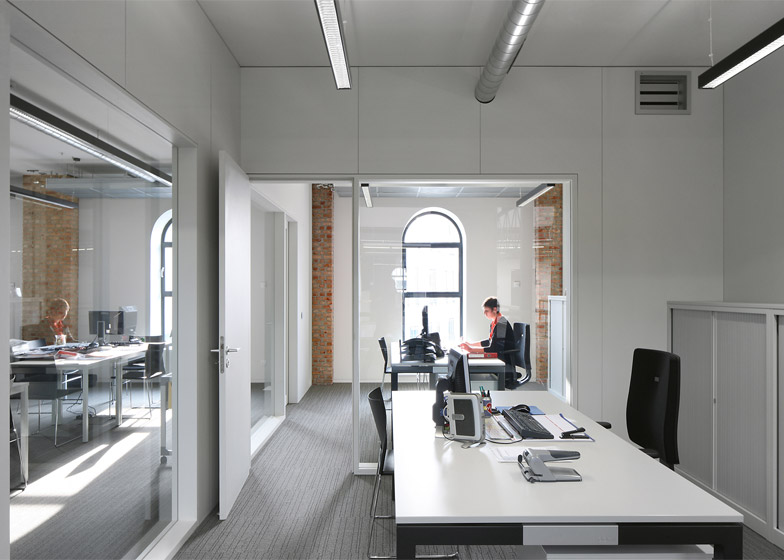Archipl-Architects has converted a 19th-century factory into the regional headquarters for a care home in Ghent, Belgium (+ slideshow).
The local studio was asked to refurbish the old brick warehouse to provide administrative offices for the Flemish organisation White Yellow Cross.
The building was originally established in 1895 as a sulphuric acid factory, and was later taken over by the washing machine company D'Hooge Laundry before ending up in the hands of the organisation.
To convert the space into offices, the architects began by stripping away superfluous structures and peeling paintwork from the disused building, leaving a brick shell, and a skeletal network of criss-crossing steel beams and columns.
Arched openings in the facade were restored, and three long pitched roofs that divide the building into bays were clad in zinc shingles.
The diamond-shaped pieces of metal create a cross-hatched pattern that emphasises the building's industrial appearance, which the architects liken in style to the factories constructed in the British city of Manchester during the same period.
"The conversion of a late 19th century warehouse in the textile history of Ghent is an example of how to shape but subtly deal with abandoned industrial heritage," said the architects.
"The new building programme was completed without touching the typology of the three-aisled building," they added. "The interventions are conceived as a subordinate new layer within the dominant structure of this typical Mancunian factory architecture."
Polycarbonate skylights are set into one gable of each roof, illuminating a large atrium that occupies the centre of the building.
Related content: more warehouse refurbishments
At night the glow from artificial lighting within creates a row of triangles along the top of one side of the building, highlighting the exposed steelwork inside.
White partitions enclose offices that sit around the periphery of the atrium on three levels. These distinguish the new parts of the building from the exposed brickwork on the outer walls.
Timber and steel bridges were added to create a series of walkways that link the offices on either side of the atrium. The timber construction of these platforms can be seen across the ceilings of offices, while the floors are covered in grey carpeting.
"The rhythm of the bays has been the starting point for the new layout while the original steel structure has been pronounced," explained the studio.
"By preserving the unfinished masonry, hence keeping the traces of construction visible, the history of this industrial heritage has been partly visualised."
Derelict factories and warehouse spaces across Europe are being converted into offices, theatres and studios with an industrial aesthetic. Among them is the headquarters of a engineering firm housed in a former Rotterdam steel plant on the banks of the Maas river, while in Gothenburg Swedish firm OkiDoki! Arkitekter set up office in an old corset factory.
Photography is by Filip Dujardin.









